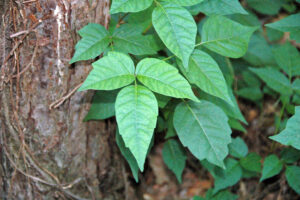Understanding and Avoiding Poison Ivy
Poison ivy, a common plant found throughout North America, is notorious for causing an itchy, blistering rash. While many of us have heard the phrase “leaves of three, let it be,” a deeper understanding of this plant can help you avoid a painful encounter.
What is Poison Ivy?
Poison ivy, along with its relatives poison oak and poison sumac, contains a resinous sap called urushiol. This oily substance is the true culprit behind the rash. Urushiol is colorless and odorless, and it’s present in all parts of the plant—the leaves, stems, and roots. The rash is an allergic reaction to this oil, and it can affect about 85% of people.
Identifying Poison Ivy
The old adage “leaves of three, let it be” is a great starting point, but it’s important to know the details:
- Compound Leaves: Poison ivy has compound leaves with three leaflets. The two side leaflets are often smaller and may have a different shape than the terminal (middle) leaflet.
- Vines: Poison ivy can grow as a low-lying shrub, but it’s most often seen as a climbing vine. The vines are often covered in what looks like “hairy” roots.
- Appearance: The leaves can vary in color, from green to reddish, and they may have a shiny or dull appearance. The edges of the leaflets can be smooth or toothed.
How the Rash Develops
The rash from poison ivy is a type of allergic contact dermatitis. When your skin comes into contact with urushiol, your immune system recognizes it as a foreign substance and mounts an attack. This leads to the characteristic red, itchy, and sometimes blistering rash.
Treating a Poison Ivy Rash
If you suspect you’ve come into contact with poison ivy, the best course of action is to wash the affected area immediately with soap and cool water. This can help remove the urushiol before it has a chance to bind to your skin. Once the rash appears, over-the-counter remedies can provide relief:
- Calamine lotion: Helps to soothe the itch.
- Hydrocortisone cream: Can reduce inflammation.
- Oatmeal baths: Provide a soothing effect.
For severe cases, a doctor may prescribe oral steroids or other medications.
Prevention is Key
The best way to deal with poison ivy is to avoid it altogether. Here are some tips for prevention:
- Learn to identify the plant: Know what poison ivy looks like in your area.
- Wear protective clothing: When hiking or working in wooded areas, wear long sleeves, long pants, and closed-toe shoes.
- Use a barrier cream: There are products on the market designed to create a protective barrier on your skin.
- Wash your tools: If you’ve been working in an area with poison ivy, wash your tools, clothing, and even your pets to remove any lingering urushiol.
By being mindful of your surroundings and taking a few simple precautions, you can enjoy the great outdoors without the worry of a poison ivy encounter.
